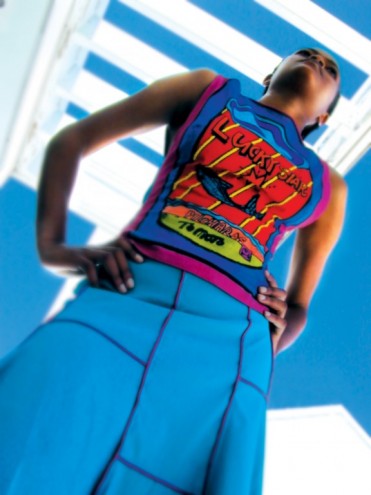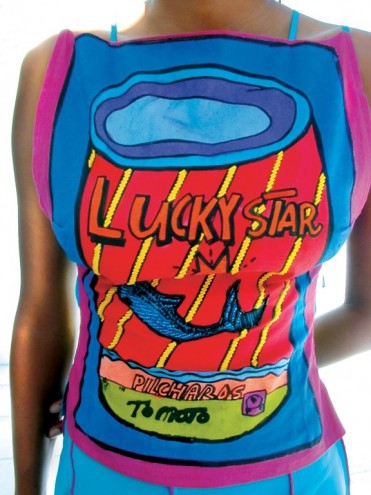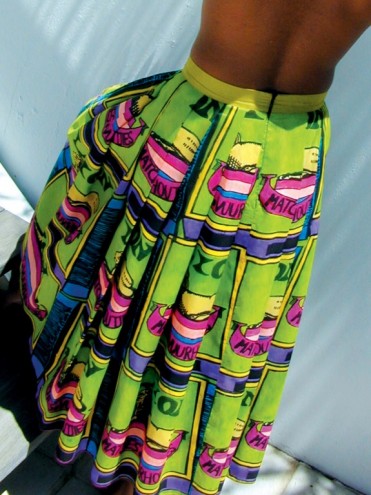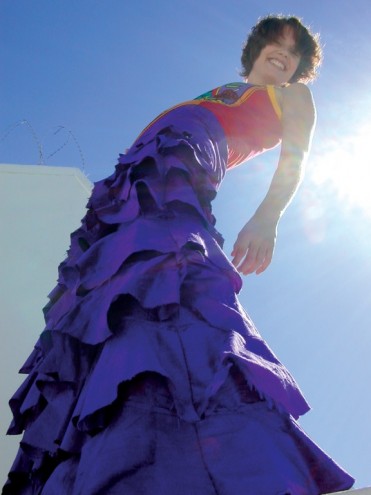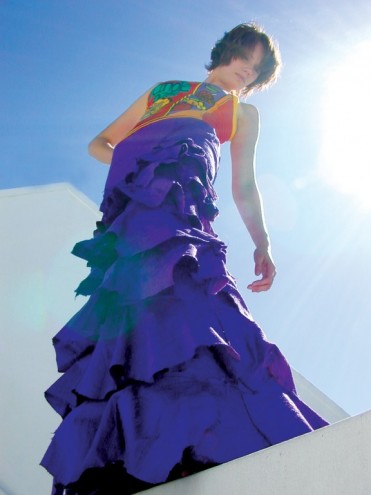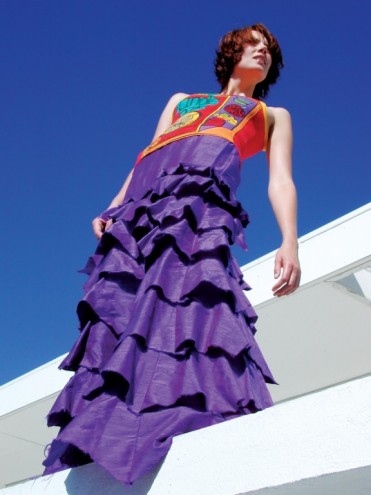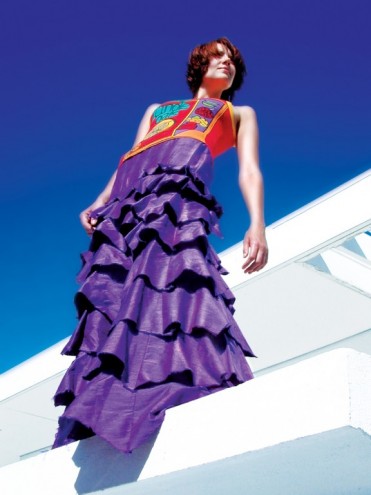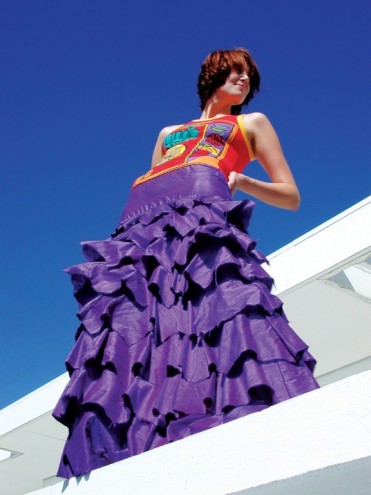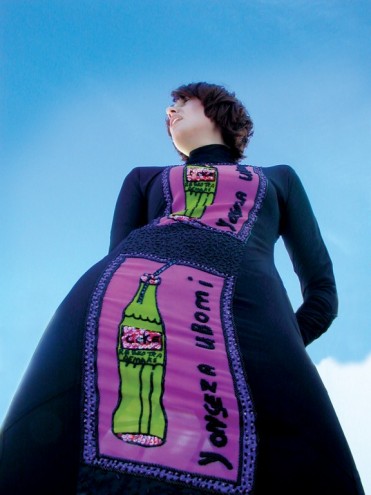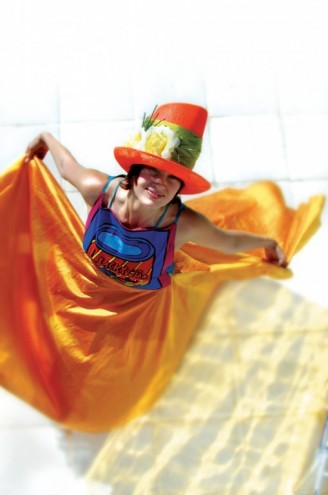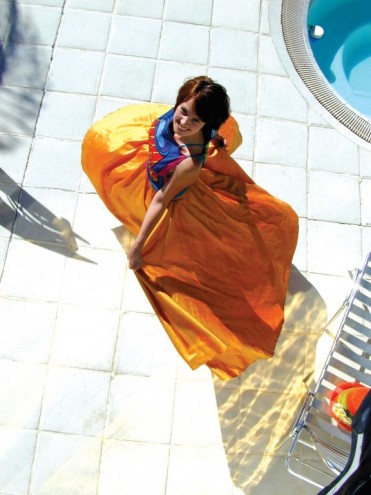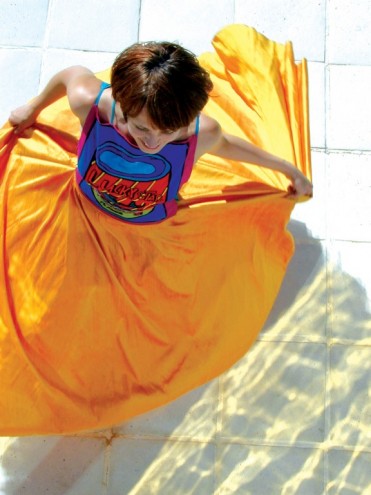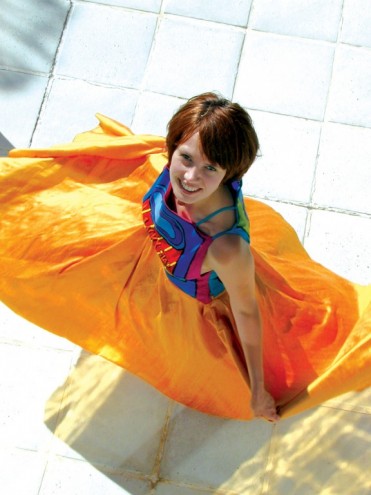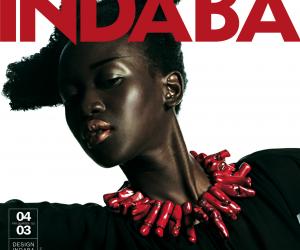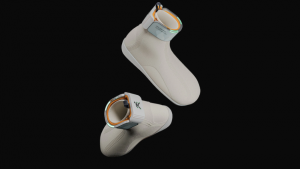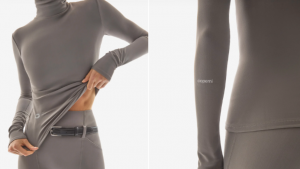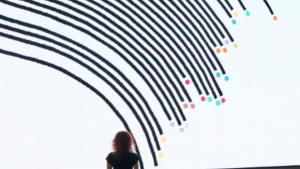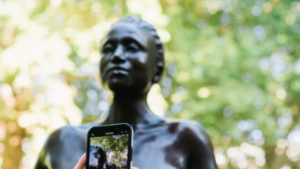First Published in
Indigenous, joyful, iconic, loudly and proudly South African… In design terms, Afro Diva is the fashion equivalent of wearing one’s heart on one’s sleeve. And the story behind the label reads like an African fairy tale.
Hip Hop’s Cheryl Arthur and Kathy Page Wood first spotted one of Nosipho Mfengwana’s silk-screens on an armchair in a curio shop. They tracked her down to a humble workshop - literally a shack - in Crossroads, on the dusty outskirts of Cape Town.
“We were designing a range for a big Johannesburg show,” says Cheryl, “the sponsor’s theme was ‘ethnic’ and we wanted to interpret it with a modern twist. The palette of the silk-screen on the chair was very plain, but the drawings were so indigenous, so quirky – we were curious to see if there were other things we could use. It was only when we found Nosipho’s workshop that we discovered these amazing prints and her talent for colour.”
Nosipho had trained in silk-screen printing at the Philani Flagship Project, a self-help initiative launched in 1997 to help unemployed women with children under five. When the Project closed because of lack of funding, she set up a small printing workshop in her home. A natural-born entrepreneur, Nosipho persuaded three fellow Philani trainees to join her and launched the company Vukani Bafazi! (Wake up, Women!).
Hip Hop fell in love with their raspberry-pink and apple-green coke bottle silk-screen and created a sexy, sheer black evening gown with appliquéd panels as the showpiece of their collection. It was somewhat ahead of its time.
“Everybody else had done ostrich and guinea fowl feathers and animal prints and Zulu beading and no one knew what the fuck we were on about”, laughs Kathy.
That was five years ago.
But great ideas have their own destiny, and good design is impossible to forget. In 2003, for Cape Town’s first Fashion Week, Hip Hop collaborated once again with Vukani Bafazi, and Afro Diva was born.
Why the name Afro Diva?
Kathy: It was a working title really, one of four themes we did for Fashion Week … little did we know it would suddenly become a label. We set out to do a collection for the international contingent of the fashion press. Because of globalisation we’re not behind trends any more, but always a season late. It’s difficult to surprise them … we wanted to design a glamorous range that was very indigenous, to set our own trend more than anything.
What came first, the silk-screens or the garments?
Cheryl: It’s been such an interesting collaboration. Between the two of us - white Africans - and Nosipho, a black African. Also between commerce and home-based township craft. We come from such different spaces and we collided; it exploded into a very beautiful product.
Kathy: We don’t influence the choice of subject matter or colours – that’s Nosipho’s domain. For the first collection, we created garments to fit the dimensions of the original designs. Going forward, we may ask Vukani Bafazi to bear specific patterns in mind.
Describe the design process.
Nosipho: We are six women, and we can draw. That’s all. Most of our time is spent printing and painting.
Cheryl: Let me add … this is very labour intensive - hand printing, hand painting, the origination of the drawing is just the first part of the crafting process.
The inspiration behind the drawings?
Nosipho: The reason I drew Lion matches? I come from a rural area in the eastern Cape… There is no electricity. So in order to cook food, to get light, we use Lion matches - that’s why I did it.
For ‘strong women of Africa’ I thought about the olden days when women had to take care of everything in the home while their husbands were away looking for jobs. This woman is breastfeeding her child, this one is sewing, this one is on the computer, this one is cooking and this one is making African beer - umqomboti.
And Jungle Oats?
Nosipho: Sorry, I don’t have a story about that one, there’s nothing important – I just love it.
Kathy: I suspect that many of the drawings are instinctive acknowledgments of good design; a nod to those household brands that have become township icons.
Cheryl: Don’t forget the colour – that’s what sets them apart from township curio art. The choice of colours is extraordinary, very brave. Every time I look at a print I think to myself how did you put those colours together? That particular shade of red with that acid green…that melon tone. But I’m a colour junkie.
Have you been influenced by Andy Warhol?
Nosipho: Who?
Kathy: I think Nosipho has got a gift that she’s not that conscious of – especially the way she puts colours together, it’s incredible.
Does each artist select her colour palette?
Nosipho: No - only two of us are good with colour, Nomonde and myself. After printing, we talk about it, and when we decide, we mix the pigments.
Cheryl: It’s such a creative process. None of the shades are pre-mixed. And the inks only work on natural fibres, which has a roll on effect on the entire garment design. That’s why we appliqué...
Hip Hop doesn’t usually do T-shirts, but Afro Diva has a range.
Cheryl: These T-shirts are different – I’m particularly madly proud about them. There’s something about the appliquéd panels that makes them three-dimensional. We picked up on the colour combinations and clashed them even more with coloured bindings. The whole garment looks like many different parts construct it. You can see that the print is not mass-produced; you can see that it’s hand-coloured because it’s inconsistent.
Kathy: And the fit is so sexy. Have you tried on the vest?
What’s next – more designs or more applications?
Kathy: The driving force behind all this is to create sustainable employment. If we can find a way to make this product more accessible to a larger market, to ensure that Vukani Bafazi has a continuous input of orders, we can do it. For that it needs to go beyond fashion, or beyond our borders - or both.
Cheryl: There are opportunities in sport, tourism, décor and the corporate sector. J&B have asked for custom-made tops. There’s an element of social responsibility too, in commissioning Afro Diva for a conference, rather than something sourced cheaply off-shore.
Kathy: On the fashion side, it has to change all the time. To grow the fashionability of Afro Diva we need to take it forward season after season... and to compete in the global marketplace we need to nurture the ‘localness’ of the designs. With globalisation, unless a product is unique, people don’t care what the source of origin is. It’s really price driven.
Is there a cheaper way?
Kathy: It would be easy to buy the designs, use commercial printers, and pay royalties for every product. But the point of this exercise is to create loads of jobs ...
Nosipho: We need work for people in the townships.
Cheryl: It’s not unusual in emerging economies for handwork, like silk beading, to be sub-contracted to households rather than factories. Why can’t we do it here?
Kathy: There’s still this frustrating hangover from Apartheid that says we can’t, rather than we can. Everything Nosipho has made for us has been delivered on time, beautifully crafted, produced in the township.
Nosipho: But we are working in my shack. It is a very small space …
Cheryl: Brett Kebble has made a donation towards a 12-metre workshop in Crossroads. It took ages to secure the site - space is at such a premium in the townships. But it will mean Nosipho can employ more women. And they can work where they live, rather than commuting and leaving their children in someone else’s care … or alone.
How else has globalisation affected the local fashion scene?
Kathy: Design-wise it’s become boring – branding has become stronger than design. When I was 22 my main aim was to look as different as possible, now with all this marketing all the kids look just the same. They all wear their jeans just above their fannies … they even eat the same food, in the same packaging.
I hear that this label has been snapped up by divas from Cape Town to Cairo?
Cheryl: It’s very new, but the response has been overwhelming. Yvonne Chaka Chaka wore custom-made Afro Diva for her solo at the 46664 concert. Kathy: A diva is someone who is in charge of her body, who has got something to say - yesterday a customer chose a bright red Afro Diva bustier as her going away outfit after her wedding. This range is not for wall-flowers.
Your favourite Afro Diva garment?
Cheryl: The first coke bottle dress!
Kathy: We have a love affair with that dress– we’ll never sell it.
Nosipho: The pink dress with the yellow panels.
Cheryl: And that skirt with the all over print is fabulous.
Dreams for Afro Diva?
Nosipho: A bigger business than this so that I can employ more people … there are many people sitting there doing nothing. I want to help them so that they can have something.
Kathy: We are hoping that someone on a global level becomes interested.
A brand for women, by women, for women. What about the boys?
Kathy: Since Hip Hop started things have changed a lot. Then, men were not very emancipated in their dress. They thought we were mad when we made them floral shirts. It’s only been in the last five years that you’ve been able to get South African men into pink shirts – even though they look so fabulous in them. The surf trend, and high-tech sportswear have been interesting influences. Maybe, with this look, we’ll move into men’s fashion again …
Cheryl: But we can’t call them divas. Afro Dudes, that’s the next step. It’s something we’ve been thinking of.
Kathy: I’d love to see Bafana Bafana (our national soccer team) in Afro Dudes.
Cheryl: And Madiba, of course.

